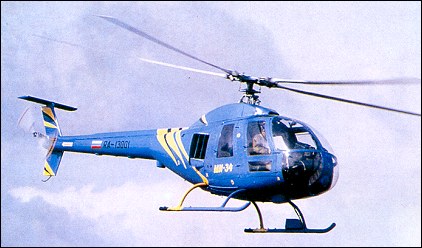
| Mil Mi-34 1982 - project |  |
 |

| Mil Mi-34 1982 - project |  |
 |
|
Codenamed 'Hermit' by NATO, the Mi-34 is a two/four-seat light helicopter in the same class as the Gazelle and Ecureuil, but powered by a piston engine. The first of two prototypes flew for the first time in 1986, and the type was revealed to the West for the first time at the Paris air show in June 1987. The Mi-34 is competing against the Polish turbine-powered Swidnik SW-4 as a replacement for the fleet of obsolete training helicopters, such as the Mi-1, used in large numbers. However, no decision has yet been made regarding series production of the 'Hermit'. A development is also under way to re-engine the Mi-34 with two 164kW VAZ-430 rotary engines normally used to power VAZ cars, and which run on Mogas. First flight of the prototype, designated Mi-34V, is scheduled for 1993. D.Donald "The Complete Encyclopedia of World Aircraft", 1997
TYPE: Four-seat helicopter. PROGRAMME: First flight 17 November 1986; two prototypes and structure test airframe completed by mid-1987, when exhibited for first time at Paris Air Show; first helicopter built in former USSR to perform normal loop and roll; series production began at Arsenyev plant in 1993; airframe manufactured by Carpathian Helicopter Production Association; marketed by Mi-Light Helicopters (LVM); Mi-34S/34C completion was at Moscow plant of LVM, but subsequently reverted to Arsenyev; planned completion of 30 in 1994-95 hampered by lack of funding; five delivered in 1995, one in first half of 1996. State order for resumed manufacture 1996. Marketing initiative, early 1999, planned worldwide establishment of service centres in countries where more than 10 Mi-34s ordered. Trials in 1999 by civil pilot training school at Omsk showed Mi-34 to be 2.8 times cheaper and more effective to operate than current fleet; school to acquire three Mi-34Cs and obtain up to 10 more in long term. Other schools expected to replace ageing Mi-2 with Mi-34. In 2001, an upgraded variant was proposed with M-14 engine rated at 272kW, IFR instrumentation and auxiliary fuel tank. An agricultural variant was planned for debut in 2003. CURRENT VERSIONS: Mi-34S: Basic version; marketed in Russia as Mi-34; certified by Interstate Aviation Committee Aviation Register (initially at 1,350kg max take-off weight), with helicopter, engine and noise type certificates; meets FAR Pt 27 requirements.
(Note that until 1999, all marketing literature for this version used the hybrid Roman/Cyrillic 'Mi-34C' to indicate certified status.)
CUSTOMERS: Total of 23 sold and 18 delivered by mid-2002, compared with estimated 425 called for in Russia's 1992-2000 civil aviation development plan. Had increased to 21 deliveries (from Arsenyev) by March 2003. First three for Mayor's office, Moscow. Others used by Bashkir Airlines and Mi-Avia for patrol and training. One operated by Bosniac and Croat Federation Air Force. Three delivered to Nigerian Air Force in 2001, along with six Mi-35s; these were from first batch of six Mi-34s built at Arsenyev, after pause of several years; further five delivered to Nigeria by end of 2002. LVM reportedly ordered 20 Mi-34s for construction at Arsenyev in 2001, but only delivery in that year apart from Nigerians was one to Sibneft. In June 2002, Russian sources reported foreign (assumed Nigerian) negotiations for "several dozen'' Mi-34s although only known 2003 production commitment is follow-on batch of four for Nigeria and five for Omsk Civil Aviation Flying and Technical College by end of 2005. COSTS: US$400,000, fully equipped (2003). DESOGN FEATURES: Acrobatic helicopter; intended initially for training and international competition flying; conventional pod and boom configuration; piston engine of same basic type as that in widely used Yakovlev fixed-wing training aircraft and Kamov Ka-26 helicopters; suitable also for light utility, mail delivery, observation and liaison duties, and border patrol; later developments concentrate on light transport role. Aerobatic capabilities include looping; backwards flight at 130km/h; and rotation about main rotor axis at 120 degrees/s. FLYING CONTROLS: Manual, with no hydraulic boost. STRUCTURE: Semi-articulated four-blade main rotor with flapping and cyclic pitch hinges, but natural flexing in lead/lag plane; blades of GFRP with CFRP reinforcement, attached by flexible steel straps to head like that of Boeing MD 500; two-blade tail rotor of similar composites construction, on starboard side; riveted light alloy fuselage; sweptback tailfin with small unswept T tailplane. LANDING GEAR: Conventional fixed skids on arched support tubes; small tailskid to protect tail rotor. POWER PLANT: One 239kW VOKBM M-14V-26V nine-cylinder radial air-cooled engine mounted sideways in centre fuselage. Fuel capacity 176 litres; system for inverted flight. ACCOMODATION: Normally one or two pilots, side by side, in enclosed cabin, with optional dual controls. Rear of cabin contains low bench seat, available for two passengers and offering flat floor for cargo carrying. Forward-hinged door on each side of flight deck and on each side of rear cabin. SYSTEMS: Primary electric power provided by 27V 3kW engine-driven generator; secondary power supplies of 115V AC, 400 Hz, single-phase and 36V AC, 400 Hz, three-phase; 27V 17Ah battery. AVIONICS:
EQUIPMENT: Gyro horizon. Version used by Moscow Police has dual controls, two rear seats and loudspeaker under rear of pod. Jane's All the World's Aircraft, 2004-2005
- The Mi-34 'Hermit' was designed as a replacement for the Mi-1/Mi-2 civil light helicopter and military trainer. - 'Hermit' is the first Soviet helicopter capable of executing a loop. - Composite materials are used for the main rotor and tail blades. - Mil first flew the Mi-34 'Hermit' in 1986, using unboosted mechanical flight controls. - A twin-engine version is built by the VAZ motor car works at Tolyatti. - The Mi-34VAZ features a totally new rotor head made from carbon fibre.
|